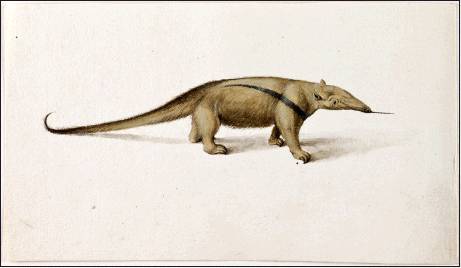Frans Post’s Original Brazilian Drawings Now At Rijksmuseum
AMSTERDAM, THE NETHERLANDS — In the Noord-Hollands Archief, Haarlem, 34 completely unknown drawings by Frans Post (1612-1680) have been discovered. The Seventeenth Century artist from Haarlem — who worked in Brazil between 1637 and 1644 — is famous for the paintings of Brazilian landscapes that he produced after his return to the Netherlands. That the native flora and fauna depicted in these paintings must have been based on original drawings made in Brazil was always suspected. Until now, however, not a single animal or plant study from his hand was known.
Alexander de Bruin, curator of the image collection of the Noord-Hollands Archief, stumbled, to his amazement, upon the unrecognized studies — which include a whitelipped peccary, Brazilian porcupine, nine-banded armadillo, capybara, jaguar and white-eared opossum — by accident in the course of a digitization project. The story of his sensational discovery has just been published in the September issue of the international journal Master Drawings.
The drawings, together with a selection of related paintings and corresponding stuffed specimens of the South American animals, lent by the Naturalis Biodiversity Center, Leiden, will be on view October 7–January 8 at the Rijksmuseum, in “Frans Post: Animals in Brazil.”
The 34 drawings, all studies of animals, came from a Seventeenth Century album that once contained 160 drawings of birds by the father and son artists Pieter Holsteijn the Elder and the Younger. The album was donated to the Noord-Hollands Archief in 1888, but the drawings by Frans Post had probably been part of it for centuries. The Brazilian animal studies were completely overlooked until De Bruin found them in 2010. The discovery was so extraordinary and unexpected that a thorough investigation was needed to establish that the drawings really were by Post. Colleagues from the Noord-Hollands Archief, Master Drawings and the Rijksmuseum worked closely together comparing the animals in the drawings with similar motifs in the paintings; it became clear that the drawings were indeed autograph studies by Post. The cache includes, for example, both a preparatory sketch and a finished gouache for the capybara in a painting in the Louvre, the only work made in Brazil to feature a prominent native animal.
Alexander de Bruin said, “These drawings with their inscriptions have an immediacy about them that makes you feel as if you were looking over Frans Post’s shoulder as he recorded the fascinating fauna of the New World. The animal studies provide the missing link between Post’s seven-year Brazilian adventure and the paintings he produced on his return to Haarlem. The Rijksmuseum and Master Drawings instantly recognized the importance of this spectacular discovery and have taken the opportunity to share it with the general public. For that I am sincerely grateful to them.”
The group consists of 24 colored drawings in gouache and watercolor and 10 sketches in graphite. Most of the drawings are annotated in a Seventeenth Century hand, the graphite studies by Post himself. Post must have made drawings of Brazilian plants, too, but these were not found in the archive.
Jane Turner, head of the Rijksprentenkabinet at the Rijksmuseum, and the editor of Master Drawings, based at the Morgan Library and Museum, New York, commented, “This is a wonderful example of collaboration on an international and a national level between the world’s leading academic publication on drawings and three truly remarkable institutions in the Netherlands. It is a project that combines cuttingedge scholarship with an exhibition of great fun for families and kids, and I, for one, am proud to be the midwife!”
The Rijksmuseum is at Rijksmuseum Museumstraat
1. For more information, www.rijksmuseum.nl or +31 20 6747 000.
WINTERTHUR, DEL. — Winterthur Museum, Garden & Library on Route 52 is presenting “Lasting Impressions: The Artists of Currier & Ives,” an exhibition of some of today’s most sought-after works that will explore the role of Frances (“Fanny”) Bond Palmer and Arthur Fitzwilliam Tait two of the most prolific artists for the iconic publisher of Christmas cards and Americana. Perhaps best known today for enchanting Christmas cards, Currier & Ives became synonymous with idealized images of Nineteenth Century American home life after opening in 1834. The exhibit is on view to January 8. For information, 800-448-3883 or www.winterthur.org.

